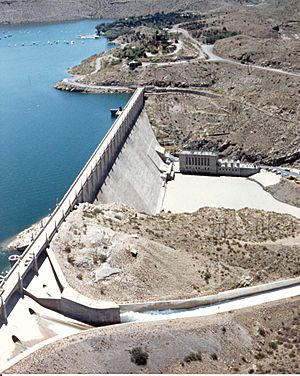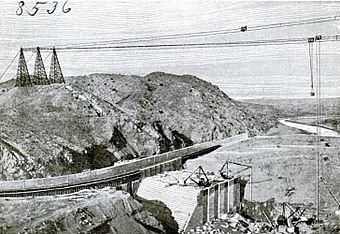Elephant Butte Dam facts for kids
Quick facts for kids Elephant Butte Dam |
|
|---|---|

The dam and reservoir at highstand
|
|
| Country | United States |
| Location | Elephant Butte, New Mexico |
| Coordinates | 33°09′14″N 107°11′32″W / 33.153969°N 107.192113°W |
| Status | In use |
| Construction began | 1911 |
| Opening date | 1916 |
| Owner(s) | U.S. Bureau of Reclamation |
| Dam and spillways | |
| Type of dam | Gravity |
| Impounds | Rio Grande |
| Height | 301 ft (92 m) |
| Length | 1,674 ft (510 m) |
| Width (crest) | 18 ft (5 m) |
| Width (base) | 228 ft (69 m) |
| Dam volume | 618,785 cu yd (473,095 m3) |
| Spillway type | Concrete chute |
| Reservoir | |
| Creates | Elephant Butte Lake |
| Total capacity | 2,065,010 acre⋅ft (2.547152329×109 m3) |
| Catchment area | 28,900 sq mi (75,000 km2) |
| Surface area | 36,500 acres (14,800 ha) |
| Power station | |
| Hydraulic head | 140 ft (43 m) (rated) |
| Turbines | 1 x Francis turbine |
| Installed capacity | 27.95 MW |
| Annual generation | 38,449,061 kWh |
|
Elephant Butte Dam
|
|

The spillway is in the lower left corner of the picture and the power plant is located at the base of the opposite side of the dam.
|
|
| Lua error in Module:Location_map at line 420: attempt to index field 'wikibase' (a nil value). | |
| Nearest city | Elephant Butte, New Mexico |
| Area | 45 acres (18 ha) |
| Built | 1910 |
| Architect | Louis C. Hill |
| Architectural style | Gravity-type |
| NRHP reference No. | 79001556 |
| Significant dates | |
| Added to NRHP | April 9, 1979 |
The Elephant Butte Dam is a huge concrete dam on the Rio Grande river in New Mexico. It was built to create the Elephant Butte Reservoir. This reservoir is super important for local farms, giving them water to grow crops. It also helps control floods, makes electricity, and is a popular spot for fun activities like boating and fishing.
Contents
What's in a Name?
The Elephant Butte Rock
The dam and lake are named after a cool rock formation called Elephant Butte. It's an old volcanic plug, which is like the hard core of a volcano that's left behind after the softer parts wear away.
This rock looks like an elephant lying down on its side. Most of the time, it's an island in the lake. But when the water level is low, you can walk to it because it connects to the land. The nearby town of Elephant Butte also got its name from this unique rock.
Other Names for the Dam
The dam was first called "Engle Dam." This name came from a nearby train stop named "Engle." The train stop was named after a construction engineer, R.L. Engle. Later, the railroad company changed the spelling to "Engel." Even though local people didn't like the change, it stuck.
Another name suggested for the dam was "Woodrow Wilson Dam," after a former U.S. president. But "Elephant Butte Dam" is the name that everyone knows today.
Building the Dam: A Look Back
Why Was the Dam Needed?
The Rio Grande river, like many rivers in the American Southwest, doesn't always have the same amount of water. Some years there's a lot of water, causing big floods. Other years, there's very little water, leading to droughts.
In the late 1800s, farmers needed more water for their crops. The river often became just a small stream near El Paso, Texas, during dry summers. To fix these problems, people started planning a large dam at Elephant Butte.
Starting Construction
The U.S. government passed a law called the Newlands Reclamation Act in 1902. This law helped fund projects like the Rio Grande Project. The goal was to bring water and power to parts of New Mexico and west Texas.
Engineers spent two years studying the best places for dams and reservoirs. Construction on the Elephant Butte Dam officially began in 1911.
Life at the Construction Site
Building such a huge dam was a massive job! Workers had to build new roads, offices, and even a hospital. They also set up camps for the thousands of people working there.
At its busiest, about 3,500 workers lived in these camps. There was an "Upper Camp" for supervisors and engineers. A "Lower Camp" was for other laborers. The Lower Camp was even separated, with American and Mexican workers living in different areas.
The Upper Camp is now underwater, covered by the lake. The Lower Camp was on dry land, but no signs of it remain today.
A Record-Breaking Dam
When it was finished in 1916, Elephant Butte Dam was one of the largest irrigation dams in the world. It created the biggest man-made lake at that time!
The dam and the Bureau of Reclamation office were added to the U.S. National Register of Historic Places in 1979. This means they are important historical sites. The larger area around the dam, including other historic buildings, is also recognized as the Elephant Butte Historic District.
Dam Facts and Figures
How Big is It?
Elephant Butte Dam is quite impressive! It stands 301 feet (about 92 meters) tall. That's taller than a 30-story building! The dam is 1,674 feet (about 510 meters) long, which is longer than five football fields.
It's made from a massive amount of concrete: 618,785 cubic yards (about 473,095 cubic meters). At the top, the dam is 18 feet (about 5.5 meters) wide, but at its base, it's a much wider 228 feet (about 69.5 meters).
The Reservoir and Power Plant
The Elephant Butte Lake can hold over 2 million acre-feet of water. This water comes from an area of 28,900 square miles (about 74,850 square kilometers). The dam helps provide water to irrigate 178,000 acres (about 720 square kilometers) of farmland.
The dam also has a hydroelectric power plant. This plant uses the force of the water to make electricity. It has one large turbine that was installed in 1940. As of 2005, this plant generates over 38 million kilowatt-hours of electricity each year!
Images for kids




